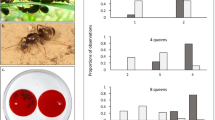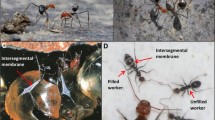Summary
Field studies ofPolyrhachis moesta revealed that colonies were facultatively founded by more than one queen, even though each established colony was inhabited by only one queen with her workers. In pleometrotic colonies, it was found that cofoundresses frequently exhibited cooperative behaviors, including trophallaxis. The results of DNA fingerprinting showed that multiple foundresses were not genetically to one another. It seems that they aggregate randomly and independently of their relatedness. A discussion of the reasons why foundresses ofP. moesta do not aggregate preferentially with genetically related females.
Similar content being viewed by others
References
Bartz, S. H. and B. Hölldobler, 1982. Colony founding inMyrmecocystus mimicus Wheeler (Hymenoptera: Formicidae) and the evolution of foundress associations.Behav. Ecol. Sociobiol. 10:137–147.
Hagen, R. H., D. R. Smith and S. W. Rissing, 1988. Genetic relatedness among co-foundresses of two desert ants,Veromessor pergandei andAcromyrmex versicolor (Hymenoptera: Formicidae).Psyche 95:191–201.
Herbers, J. M., 1986. Nest site limitation and facultative polygyny in the antLeptothorax longispinosus.Behav. Ecol. Sociobiol. 19:115–122.
Hölldobler, B. and N. F. Carlin, 1985. Colony founding, queen dominance and oligogyny in the Australian meat antIridomyrmex purpureus.Behav. Ecol. Sociobiol. 18:45–58.
Hölldobler, B. and E. O. Wilson, 1990.The Ants. The Belknap Press of Harvard University Press, Cambridge, Mass. pp. 217–220.
Lynch, M., 1990. The similarity index and DNA fingerprinting.Mol. Biol. Evol. 7:478–484.
Mintzer, A., 1979. Colony foundation and pleometrosis inCamponotus (Hymenoptera: Formicidae).Pan-Pacific Entomologist 55:81–89.
Nonacs, P., 1989. Competition and kin discrimination in colony founding by social Hymenoptera.Evol. Ecol. 3:221–235.
Nonacs, P., 1990. Size and kinship affect success of co-foundingLasius pallitarsis queens.Psyche 97:217–228.
Post, D. C. and R. L. Jeanne, 1982. Recognition of former nestmates during colony founding by the social waspPolistes fuscatus (Hymenoptera: Vespidae).Behav. Ecol. Sociobiol. 11:283–285.
Reeve, H. K., D. F. Westneat and D. C. Queller, 1992. Estimating average within-group relatedness from DNA fingerprints.Mol. Ecology 1:223–232.
Rissing, S. W. and G. B. Pollock, 1986. Social interaction among pleometrotic queens ofVeromessor pergandei (Hymenoptera: Formicidae) during colony foundation.Anim. Behav. 34:226–233.
Rissing, S. W., R. A. Johnson and G. B. Pollock, 1986. Natal nest distribution and pleometrosis in the desert leaf-cutter antAcromyrmex versicolor (Pergande) (Hymenoptera: Formicidae).Psyche 93:177–186.
Rissing, S. W. and G. B. Pollock, 1987. Queen aggression, pleometrotic advantage and brood raiding in the antVeromessor pergandei (Hymenoptera: Formicidae).Anim. Behav. 35:975–981.
Ross, N. M. and G. J. Gamboa, 1981. Nestmate discrimination in social wasp (Polistes metricus, Hymenoptera: Vespidae).Behav. Ecol. Sociobiol. 9:163–165.
Ross, N. M. and D. J. C. Fletcher, 1985. Comparative study of genetic and social structure in two forms of the fire antSolenopsis invicta (Hymenoptera: Formicidae).Behav. Ecol. Sociobiol. 17:349–356.
Sommer, K. and B. Hölldobler, 1992. Pleometrosis inLasius niger. In:Biology and Evolution of Social Insects (J. Billen, Ed.), Leuven University Press, Leuven, Belgium. pp. 47–50.
Sommer, K. and B. Hölldobler, 1995. Colony founding by queen association and determinants of reduction in queen number in the antLasius niger.Anim. Behav. 50:287–294.
Strassmann, J. E., 1983. Nest fidelity and group size among foundresses ofPolistes annularis (Hymenoptera: Vespidae).J. Kansas Entomol. Soc. 56:621–634.
Strassmann, J. E., 1989. Altruism and relatedness at colony foundation in social insects.Trends Ecol. Evol. 4:371–374.
Tschinkel, W. R. and D. F. Howard, 1983. Colony founding by pleometrosis in the fire ant,Solenopsis invicta.Behav. Ecol. Sociobiol. 12:103–113.
Waloff, N., 1957. The effect of the number of queens of the antLasius flavus (Fab.) (Hym., Formicidae) on their survival and on the rate of development of the first brood.Ins. Soc. 4:391–408.
Westneat, D. F., W. A. Noon, H. K. Reeve and C. F. Aquadro, 1988. Improved hybridization condition for DNA fingerprints probed with M13.Nucleic Acids Res. 16:4161.
Author information
Authors and Affiliations
Rights and permissions
About this article
Cite this article
Sasaki, K., Satoh, T. & Obara, Y. Cooperative foundation of colonies by unrelated foundresses in the antPolyrhachis moesta . Ins. Soc 43, 217–226 (1996). https://doi.org/10.1007/BF01242573
Received:
Revised:
Accepted:
Issue Date:
DOI: https://doi.org/10.1007/BF01242573




